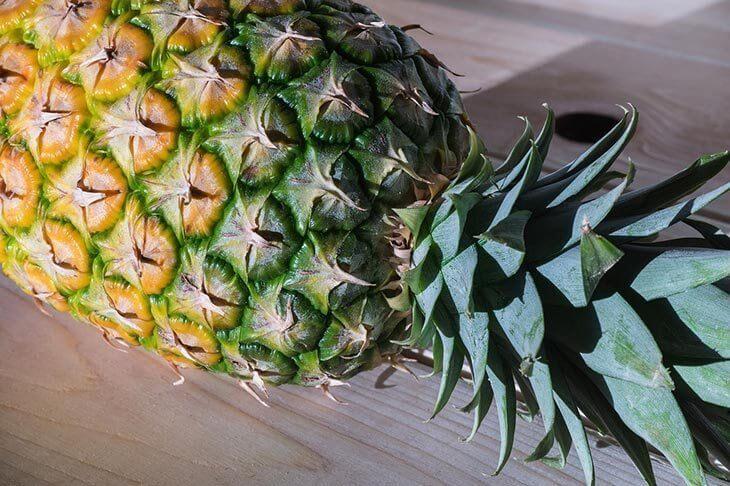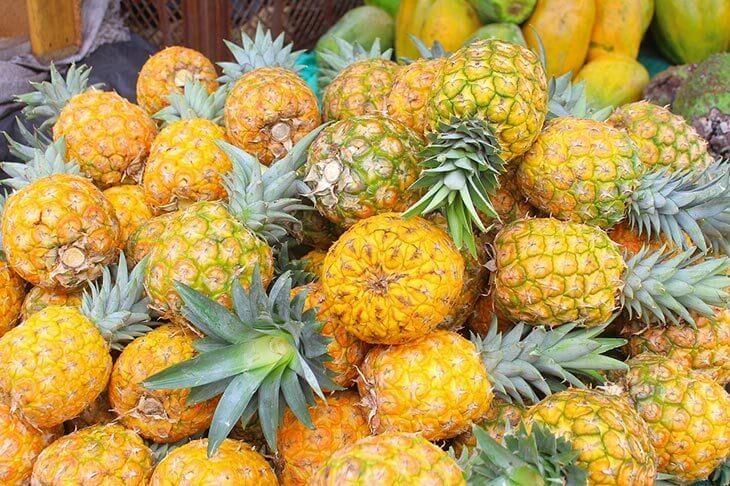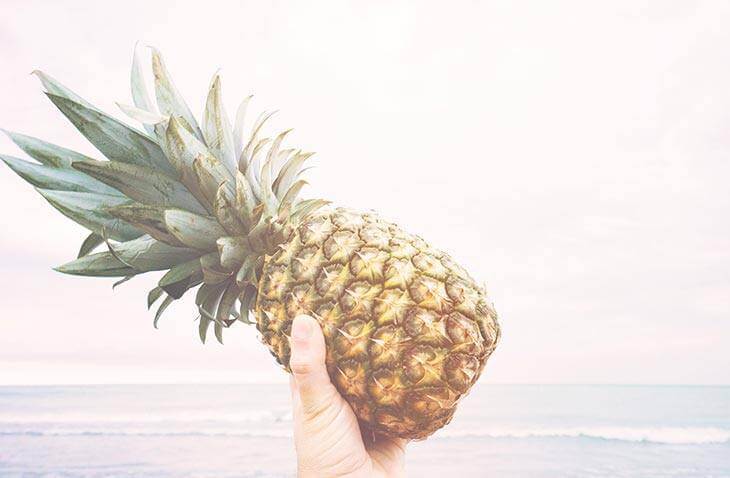I used to be intimidated by fresh pineapples because I didn’t know how to pick the right one. I kept asking my friends who were experts in fruits, “How do you know when a pineapple is ripe?” Thankfully, they were kind enough to give me useful tips on how to choose a ripe pineapple.
When I finally overcame my worries and bought a fresh piece from the supermarket, I discovered that a fresh pineapple tastes way better than a canned one!
If you’re worried that you won’t know how to choose a pineapple, then don’t be! I’m here to teach you what I learned on the best ways to pick a ripe pineapple from the supermarket pile.
How Do You Tell if A Pineapple is Ripe?
Before you buy a pineapple from the supermarket, here are some easy tips to help you know if you’re buying a ripe one or not:
By Appearance

Check the pineapple’s color. Many pineapples turn golden yellow when ripe, but a green exterior doesn’t necessarily mean that the fruit is still unripe.
The yellow color usually starts at the base of the fruit, so you may want to check there first. As the color yellow rises further up the fruit’s body, its flesh usually tends to become sweeter.
While a greenish pineapple may still be ripe, avoid buying a pineapple that is green all over. Don’t get something that is color brown either. This usually indicates that the fruit has already become rotten.
If you find that checking the color of the actual fruit is a bit confusing, you can also check the color of the leaves. Pick a pineapple that has healthy green leaves instead of drooping brown ones.
Keep an eye out for molds, cracks, and leaks. Pineapples with wrinkled skin are most likely rotten, so I highly advise you to stay clear of them.
Finally, look at the general shape of the pineapple. A good, ripe pineapple should have rounded edges instead of uneven ones. Then check the eyes, or the small circles with spiked centers scattered symmetrically across the fruit. Ideally, these should be flat, filled out, and well developed.
By Scent

Don’t feel embarrassed about smelling the pineapple before buying it, because its scent is usually a good indication of the freshness and ripeness of the fruit.
To check the ripeness of a pineapple by scent, flip over the pineapple to its base and take a whiff of the end of its stem. Fresh and ripe pineapples normally smell sweet. If you can’t smell anything, there’s a good chance that the pineapple is still unripe.
On the other hand, if you smell something sour, alcoholic, or fermented, then this means that the pineapple has become overripe and is on its way to becoming rotten. Avoid buying this because you will only end up throwing it away.
Of course, you can also smell other sides of the pineapple, but it is best if you smell it from the base since this is the part that ripens first.
By Touch

Test the weight of the pineapple by picking it up and weighing it with your hand. A heavier pineapple is usually juicier, which usually means that it is sweeter. Note, however, that a bigger pineapple isn’t always the sweeter one. Sometimes a smaller pineapple is sweeter if it weighs only slightly lighter than a bigger one.
You can also squeeze the pineapple lightly with your fingers to check its firmness. Instead of a very soft exterior, I recommend picking a fruit that is firm but is soft enough that your fingers will sink down a bit when you press them against the fruit.
Many people also try plucking a leaf from the top of the pineapple to test its ripeness. The leaves of a ripe pineapple should resist a bit but can still be pulled out. If the leaf can be yanked out easily, it’s probably beginning to rot already. If it’s too hard to pull out, then the pineapple is probably still unripe.
How Do You Cut a Pineapple?
Cutting a pineapple can be intimidating at first, but it really isn’t such a hard task. Check out this video for a quick and easy tutorial on how to cut a pineapple without fuzz:
Step 1: Lay your pineapple on its side and cut off its base and top.
Step 2: Stand your pineapple up and slice it through the center, lengthwise, so you end up with two equal halves.
Step 3: Using your knife, slice through the edges of the pineapple’s core to take it out.
Step 4. Slice each half of the pineapple in two so you end up with four parts. Take one quarter and slice it again in half. Do not slice it all the way down but just enough so that it reaches the edge of the inner skin.
Step 5: Make half-inch slices on the quartered pineapple until you’ve cut all the way down.
Step 6: Slice through the flesh of the pineapple and the skin. You can then serve the pineapple bits on the skin or transfer them in another bowl or container.
Conclusion
See? Picking fresh ripe pineapples isn’t that hard. Just remember to check for signs of ripeness: The fruit should be golden yellow, must have green healthy leaves and a sweet scent, and is firm to the touch (but not too much!). Master these and you won’t have to worry about picking your fresh pineapples again.
Got any comments? Leave them in the comments’ section below. I’d love to hear from you! And please take the time to share this article and my tips with your family and friends. Until next time!
Helpful Links
How to Tell if a Pineapple is Ripe (WikiHow)
How to Tell if a Pineapple is Ripe (Canadian Living)
How to Cut a Pineapple (Clean and Delicious)



























